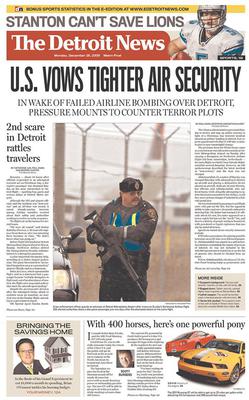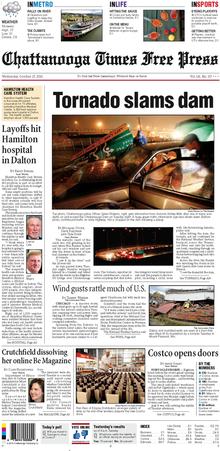Related Research Articles

Minoru Yamasaki was a Japanese-American architect, best known for designing the original World Trade Center in New York City and several other large-scale projects. Yamasaki was one of the most prominent architects of the 20th century. He and fellow architect Edward Durell Stone are generally considered to be the two master practitioners of "New Formalism".

Toshio Sakai was a Japanese photographer for United Press International. He was the first winner of the Pulitzer Prize for Feature Photography.

The Detroit Free Press is a major daily newspaper in Detroit, Michigan, United States. It is the largest local newspaper owned by Gannett, and is operated by the Detroit Media Partnership under a joint operating agreement with The Detroit News, its historical rival. The Sunday edition is titled the Sunday Free Press.

The Detroit News is one of the two major newspapers in the U.S. city of Detroit, Michigan. The paper began in 1873, when it rented space in the rival Detroit Free Press's building. The News absorbed the Detroit Tribune on February 1, 1919, the Detroit Journal on July 21, 1922, and on November 7, 1960, it bought and closed the faltering Detroit Times. However, it retained the Times building, which it used as a printing plant until 1975, when a new facility opened in Sterling Heights. The Times building was demolished in 1978. The street in downtown Detroit where the Times building once stood is still called "Times Square." The Evening News Association, owner of The News, merged with Gannett in 1985.

David Hume Kennerly is an American photographer. He won the 1972 Pulitzer Prize for Feature Photography for his portfolio of photographs of the Vietnam War, Cambodia, East Pakistani refugees near Calcutta, and the Ali-Frazier fight in Madison Square Garden. He has photographed every American president since Lyndon B Johnson. He is the first presidential scholar at the University of Arizona.

Alexander Vadimovich Zemlianichenko is a Russian photojournalist, two times Pulitzer Prize winner.
The Pulitzer Prizes for 1981 were announced on April 13, 1981.

The Chattanooga Times Free Press is a daily broadsheet newspaper published in Chattanooga, Tennessee, and is distributed in the metropolitan Chattanooga region of southeastern Tennessee and northwestern Georgia. It is one of Tennessee's major newspapers and is owned by WEHCO Media, Inc., a diversified communications company with ownership in 14 daily newspapers, 11 weekly newspapers and 13 cable television companies in six states.

One Woodward Avenue is a 28-story office skyscraper in downtown Detroit, Michigan. Located in the city's Financial District, it overlooks Hart Plaza and the International Riverfront. It was designed by Minoru Yamasaki in the International style, and completed in 1962.
Yamasaki Associates, Inc. was an architectural firm based in Troy, Michigan. Its founder, Minoru Yamasaki, was well known for his design of the twin towers of the World Trade Center.

Arnold Hardy was the first amateur photographer who won the 1947 Pulitzer Prize for Photography.
Daniel Berehulak is an Australian photographer and photojournalist based in Mexico City. He is a staff photographer of The New York Times and has visited more than 60 countries covering contemporary issues.

The McGregor Memorial Conference Center is a meeting and event facility on the campus of Wayne State University in Midtown Detroit, Michigan, designed by noted Japanese American architect Minoru Yamasaki (1912–1986) and completed in 1958. The design marks a shift in style from Yamasaki's earlier International Style work to the New Formalism of his later years. The building was designated a National Historic Landmark for its architectural quality in 2015.

Frank E. "Pappy" Noel was an Associated Press photographer and the winner of the 1943 Pulitzer Prize for Photography, the second winner of that prize.

William M. Gallagher was an American photographer who won the 1953 Pulitzer Prize for Photography for his photograph of presidential candidate Adlai Stevenson II. Gallagher was a photographer for 27 years with the Flint Journal in Flint, Michigan.
Thomas J. Kelly III, born in Hackensack, New Jersey, is an American, Pulitzer prize-winning photojournalist. Based in greater Philadelphia, he has worked as a freelancer for electronic and print outlets since 1995. Kelly joined the staff of The Mercury in Pottstown, Pennsylvania in 1974, where he won the 1979 Pulitzer prize for spot news photography; he left The Mercury in 1989.
Heather Ann Thompson is an American historian, author, activist, professor, and speaker from Detroit, Michigan. Thompson won the 2017 Pulitzer Prize for History, the 2016 Bancroft Prize, and five other awards for her work Blood in the Water: The Attica Prison Uprising of 1971 and Its Legacy. This book was also a finalist for the Cundill Prize in History as well as the National Book Award and the LA Times Book Award. She is the recipient of several social justice awards as well, including the Life-Long Dedication to Social Justice Award. Alliance of Families for Justice and the Regents Distinguished Award for Public Service.She was awarded the Pitt Professorship of American History and Diplomacy in 2019-2020 and received a Guggenheim Fellowship in 2022. Thompson was also named a distinguished lecturer by the Organization of American Historians.
Sheryl Teresa James is a Pulitzer Prize-winning journalist and author. She won the Pulitzer Prize for Feature Writing in 1991 for a series she wrote in the St. Petersburg Times about a mother who deserted her baby. Her reporting has also been in the Detroit Free Press, the Greensboro News and Record, and City Magazine in Lansing, Michigan.

Manny Crisostomo is a photojournalist and Pulitzer Prize winner from Guam.
David Charles Peterson is an American photographer and journalist, winner of the Pulitzer Prize for Feature Photography in 1987. Peterson also shared the Pulitzer Prize in 1991 for Community Service with two other staff members of the Des Moines Register. David Charles Peterson was born on October 22, 1949, to John Edward Peterson and Florence Athene, in Kansas. In 1971 he graduated with a Bachelor of Science in Education from the Kansas State University. Three years later he received a Bachelor of Science in Journalism from the University of Kansas. In 1975 he became the staff photographer at the Topeka Capital-Journal, after two years he switched to the Des Moines Register.
References
- ↑ About the Detroit Free Press Retrieved December 23, 2010
- ↑ "The Pulitzer Prizes – Feature Photography." Retrieved December 23, 2010.
- 1 2 3 4 5 "Who's who of Pulitzer Prize Winners" Elizabeth A. Brennan, Elizabeth C. Clarage. (Google eBook). page 209. Greenwood Publishing Group. 1999. Retrieved December 23, 2010
- 1 2 3 4 5 Taro Yamasaki's Biography [ permanent dead link ] Retrieved December 23, 2010.
- ↑ "Minoru Yamasaki, world class architect." Archived July 1, 2012, at archive.today Baulch, Vivian M. The Detroit News August 14, 1998. Retrieved December 23, 2010.
- ↑ "Who's who of Pulitzer Prize Winners" Elizabeth A. Brennan, Elizabeth C. Clarage. (Google eBook). page 209. Greenwood Publishing Group. 1999. Retrieved December 23, 2010.
- ↑ "Art: The Road to Xanadu – TIME." Baulch, Vivian M. Time Magazine. January 18, 1963. Retrieved December 23, 2010.
- ↑ Penn GSE Perspectives on Urban Education Volume 4, Issue 2: Winter 2006 Biography. [usurped] Retrieved December 23, 2010.
- ↑ "Portrait, Taro Yamasaki, Detroit, 1981". Spina, Tony. Walter P. Reuther Library. April 27, 2010. Retrieved December 23, 2010.
- 1 2 3 Yamasaki, Taro. "Inside Jackson". Detroit Free Press. December 14, 1980. Accessed December 23, 2010.
- ↑ Taro Yamasaki Website Biography. Retrieved December 23, 2010.
- ↑ Schulze, Franz. "Mariotti". Herring PRess. 1988. Retrieved December 23, 2010.
- ↑ Penn GSE Volume 4, Issue 2: Winter 2006. [usurped] Retrieved December 23, 2010.
- ↑ Visions: Taro Yamasaki Retrieved December 23, 2010
- ↑ 20 Years: AIDS & Photography. Retrieved December 23, 2010.
- ↑ "Children, Literacy and Mass Trauma Teaching in Times of Catastrophic Events And On Going Emergency Situations". [usurped] Taylor, Denny and Taro Yamasaki. Penn GSE Perspectives on Urban Education | Volume 4, Issue 2 | Feature Articles | Children and Mass Trauma. Retrieved December 23, 2010.